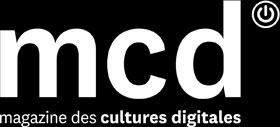ramp up their response
> français
In the UK, the Covid-19 crisis has mobilised citizens eager to join the common fight against the pandemic. DIY problem-solving makers and open-source engineers, in collaboration with clinical teams, are contributing their technical expertise to the collective response.
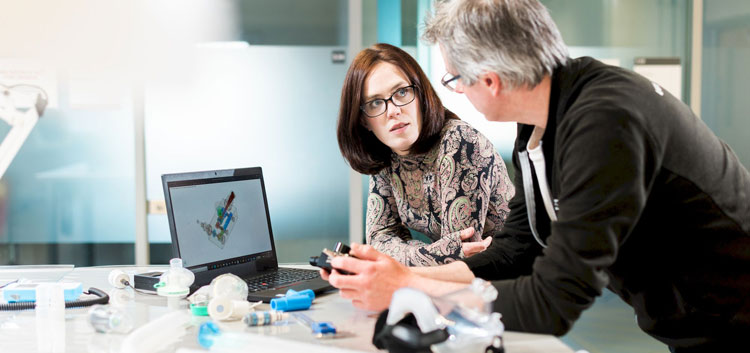
Professors Rebecca Shipley and Tim Baker of UCL Mechanical Engineering worked on an open source ventilator for Innovation Action. Photo: © UCL
Since March, and the beginning of the lockdown, the UK has seen myriad maker responses to the pandemic, more or less organised in networks. Among the dozens of initiatives, a few projects stand out: Innovation Action, a platform usually focused on assistive technologies for disabled people, donated its resources to serve the fight against Covid-19; Helpful Engineering UK, a delegation of the international network Helpful Engineering, mobilised some 3,500 people sharing models and contributing skills; SHIELD, a cooperative of associations, consolidated efforts by linking projects to complementary strengths through a national database of institutions, many lacking materials (around 250,000 pieces, or £1M (1.12M€) of equipment have been distributed through this platform).
Makerspaces are also taking action locally. In Cambridge, Makespace members develop open source projects, which they produce, document, share online and deliver throughout the city. In southwestern Cornwall, the art-science-nature lab Foam produces cloth masks that they deliver to care homes or community care groups—as an example of the “cottage industry”, where individuals produce and sew from their homes with provided materials, reminiscent of the domestic industry of the proto-industrial era. In total, 4000 masks have been sewn for Cornwall’s care homes.
“The interesting thing is that without any top-down governmental support, an alternative distribution network has appeared, seemingly very quickly,” explains Foam co-founder Dave Griffiths. “We e-mail our contact when we have a batch ready to go, they tell us the address of a care home or community care group who need them. It was alarming when the local hospital started asking for them.”
In the cottage industry, masks are sewn on centenary machines (such as this 1911 Singer):
Top priority: PPE
The UK is no exception when it comes to the dire shortage of personal protective equipment (PPE). Face shields are first in line, and often the first response of most local initiatives. “They were clearly in shortage and relatively easy to manufacture,” sums up Nigel Daly, head of Helpful Engineering’s UK delegation (HEUK).
Some 8,000 volunteers from 3DCrowd, a community of “3D printing warriors”, printed and delivered more than 65,000 single-use face shields to National Health Service (NHS) workers—“a kind of face-shield Amazon (but free)”—thanks to over £138,000 (154,000€) in donations. In Cambridge, Makespace produced more than 5,500 shields. Once the equipment was distributed to local healthcare workers, the community launched a call to deliver the 3,500 remaining units: “We were overwhelmed with responses from care homes, schools, hospices, funeral homes, people looking after their parents.”
At SHIELD, an umbrella organisation that includes Women in 3D printing, HEUK and Med Supply Drive UK, volunteers produce 1,200 to 1,500 goggles, face-shields and masks per day, and aim to produce 10,000 units daily. The organisation relies on their “3d printing farm” of some 70 3D printers at Makerversity, a makerspace/accelerator in Somerset House. “We iterated on the 3D printers,” explains Dominic Pimenta, cardiologist, co-founder of SHIELD and president of the nonprofit organisation Heroes, through which he raised more than £650,000 (724,000€), where £305,000 (340,000€) went toward PPE production. “It takes a lot of quality-control time and a lot of manual work. Next stage, we are going to try injection moulding.” It’s also a more efficient technique that “removes the need to clean the headband before going out”.
HEUK volunteers collaborated with the makerspace Building Bloqs, which gave them free access to laser cutters and mobilised its community. “We are proud to see how quickly we have been able, in two weeks, to mobilise our community, source materials, produce 5,000 face shields and publish the documentation,” comments Makespace member Julia Citron.
Introduction to SHIELD, late April 2020
Expert communities
During this health crisis, makerspaces have fully assumed their role as innovative rapid prototypers, who are also agile in finding funding and mobilising their volunteer communities, with highly sharpened skills and expertise.
Between SHIELD and HEUK, skills are complementary. “We are providing technical and manufacturing advice,” explains HEUK’s Nigel Daly, himself a manager of engineering projects. “SHIELD are helping us in terms of distribution, clinical feedback and funding.” In addition to having a close relationship with healthcare workers, SHIELD’s Dominic Pimenta has been able to test the prototypes directly through his work as a cardiologist.
In Cambridge, this high level of expertise has been key to an efficient response. Makespace created a database where each member was invited to list their skills, so that the team could then match specific makers to specific projects and needs. “One of our community members works for the mechanical engineering department of the local hospital,” says Julia Citron. “We made a spreadsheet with all the designs that people have seen online, a list of ventilators, masks, goggles, gloves. We shared it with the clinic through this person and asked which ones they needed in priority.” She says that another member, who is a software developer, “created a software to track the batches, so if someone came and later had symptoms of Covid-19, we knew which batches they touched and could put these boxes in quarantine.”
From DIY to mass production
Beyond their proven methods of action, volunteers also created links with local industries. Confronted with the shortage of plastic for face shields, Makespace was able to source materials through another one of their members, who is employed in the food-packaging industry. “Our role is not in mass manufacturing,” Citron emphasises. “Once the design is approved, the documentation is published and shared with local industries, which have production capacities of up to 10,000 units a day.”
SHIELD works closely with industries such as Rolls-Royce, which helped them cut face shields, as well as manufacturers of plastic and 3D printers. The organisation is currently trying to maintain a steady and sustainable production line, while securing government funding in order to scale up production.
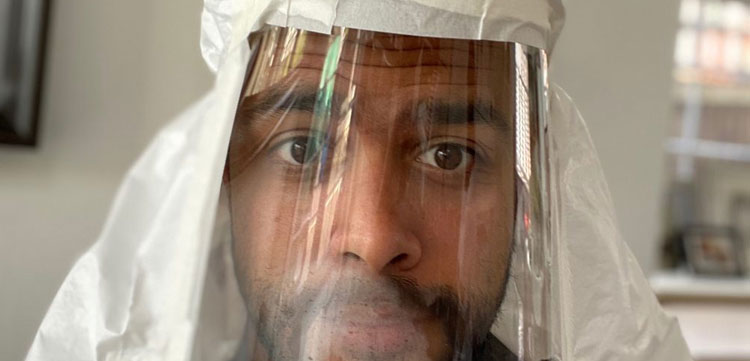
Cardiologist and SHIELD founder, Dominic Pimenta, ready for his shift. Photo: © Dominic Pimenta
The certification conundrum
Acting on behalf of the greater good without self-interested profit isn’t easy, especially when it comes to equipment certification. HEUK’s Nigel Daly regrets that regulation standards, as defined by BSI, are extremely exacting: “The barriers in terms of cost and time for small-scale manufacturers are high. Our testing for the face shields takes 3 to 4 weeks and costs 1,000 pounds [almost 1200€].”
If some tests are common sense, such as making sure the visor covers enough of the face to be protective, some are “less sensible”, says Daly. “For example, you have to put your visor in an oven at 55 degrees for 60 minutes and test to see if it deforms. This scenario is not going to happen. Any visor would melt in these conditions.” This might be understandable for sterilising the equipment, but it is done chemically using 70% alcohol, Daly retorts.
“To get certification is incredibly difficult,” confirms Dominic Pimenta. “And rightly so.” SHIELD members developed a ventilator with a filter from a scuba mask. The model is currently being tested by BSI, at a cost of £18,000 (20,000€) to be footed by the organisation. “Once it is an approved product, we can donate it all over the world!” Pimenta rejoices.
One of the main hurdles is the CE marking, a lengthy and costly certification that is compulsory for local action, Daly explains. If an organisation wishes to give the equipment produced to central NHS procurement, the latter will be in charge of the certifications. “Most local charities want to meet local needs,” says Daly, especially since the central procurement service has been impacted by confusion and dysfunction. Notably, the government assured that there was no shortage but instead “distribution issues”, before admitting some problems with supply.
A number of alternative spaces used designs that had been approved by NGOs or had already been used by hospitals, but on May 7 the British government published some rules to follow in making PPE. Is it now clear that charities are responsible for the safety of the material they provide. “A lot of charities either stopped producing while they thought about what to do or are going to withdraw altogether,” Daly says.
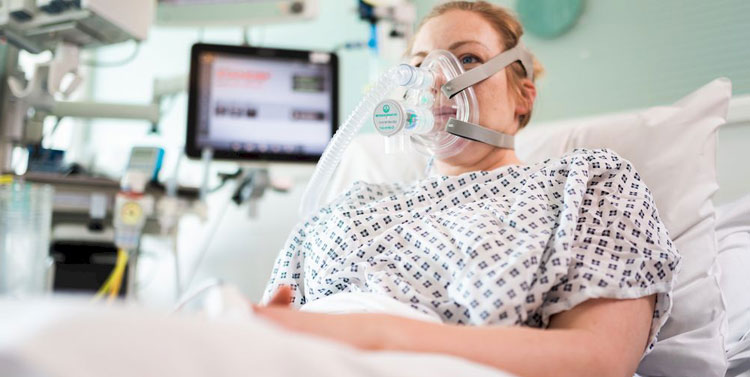
The “UCL-Ventura” device offers non-invasive ventilation. Photo: © James Tye / UCL
Academic and government alliance
Innovation Action is attempting to smoothe out the certification process. The multidisciplinary team represents several organs of the University College of London (UCL): the in-house makerspace Institute of Making, Global Disability Innovation (GDI) Hub, Institute of Healthcare Engineering and clinical partners from the University College Hospital. Born out of the legacy of the London 2012 Paralympic Games, GDI Hub was launched in 2016 to tackle assistive technologies and received a generous government funding of £20 million (22.4 million €). The team received an additional funding of around £2,000 (2,240€) to adapt its platform to respond to the Covid-19 crisis, and now works in close relationship with the government initiative Covid Action.
One of the flagship projects of this initiative is the development of Continuous positive airway pressure (CPAP), a non-invasive ventilation device that requires an unforgiving certification process. Once they were authorised by the Medicines and Healthcare products Regulatory Agency (MHRA), Innovation Action published the open source documentation, “but only for those who are capable of manufacturing the device,” says Catherine Holloway, academic director of GDI, in order to ensure that the device is conscientiously reproduced.
The “UCL-Ventura” device is currently deployed in nearly 50 NHS hospitals across the UK, while the details have been downloaded by more than 1,800 teams from 105 countries. “20 teams have manufactured prototypes for testing,” says Holloway.
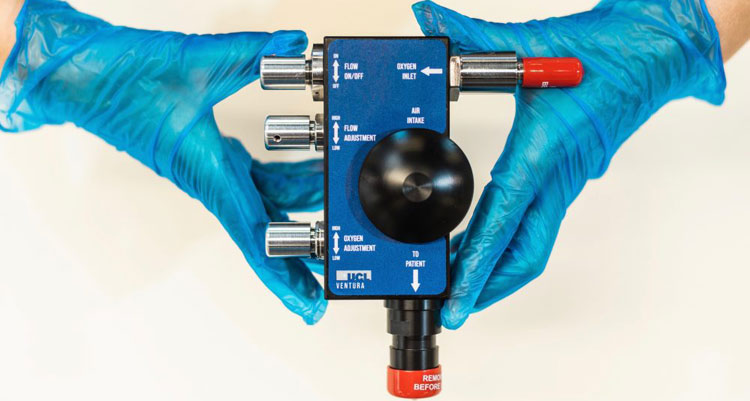
CPAP device, developed by Innovation Action’s multidisciplinary team. Photo: © James Tye / UCL.
Single-use equipment and problem-solving
Beyond their immediate response to the health crisis in producing hundreds of thousands of face shields and masks, the UK maker community has also been rediscovered as a precious resource for problem-solving.
“The local hospital came to us with a huge shipment of surgical masks with elastic loops,” recalls Julia Citron. “They had a few problems: They weren’t tight enough, so not very safe. They were also very uncomfortable to wear all day.” Makespace shared the problem with its community and received 15 proposals in 48 hours. “We produced two prototypes and put them in testing at the hospital. Doctors and nurses voted for their favourite design, and we published the model so they could be made to scale.”
Another major problem is the use of disposable materials. Beyond the obvious environmental challenge – a surgical mask takes 450 years to disintegrate – single-use equipment is an urgent problem for healthcare workers and the capacity to build stock. Some makerspaces mark their face shields with a single-use warning, while making sure they can also be sterilised and reused. “Even if you reuse your mask just once, you double your stock,” points out Dominic Pimenta.
One of the main difficulties in designing the masks was how to make them fit on each individual’s face. “The problem we have with the mask we are using right now is not the quality of materials, it is recognised as being very effective,” Pimenta explains, referring to the scuba mask-turned-respirator. “The problem is the fit: 70% of NHS workers or healthcare workers would fail that fit test. This is why the legal requirement is that everybody is fit-tested, but it is variable if masks are disposable. If you get fit-tested for a mask, and you come to work and can’t find that mask, then what do you do?”
He made this challenge his main focus and, in collaboration with Doctor Jasmine Ho, founder of Med Supply Drive UK, he currently lobbies for the testing of a decontamination technique by vaporised hydrogen peroxide, which would allow the masks to be re-used up to 20 times. The system was developed by Battelle, an Ohio-based research and development nonprofit, and was approved by the U.S. Food and Drug Administration (FDA).
Meanwhile, HEUK has already launched itself into the next challenge: making a “pandemic airway guard”: a sort of polycarbonate box that serves as an extra layer of protection when intubating a patient—an activity that places the medical staff at high risk of exposure to aerosols. “There are hundreds of people who want to make a difference,” says Nigel Daly. “It is an inspiring story, it helps us to focus and not feel powerless.”
Elsa Ferreira
published in partnership with Makery.info
https://twitter.com/3dcrowduk/status/1259890705067134983
1st off the production line. pic.twitter.com/XlSQ1pA45V
— Makespace (@cammakespace) March 29, 2020
